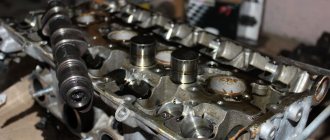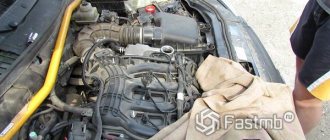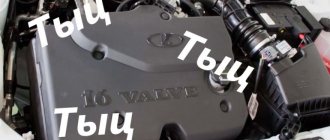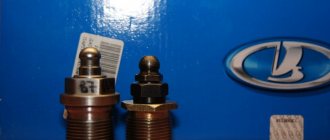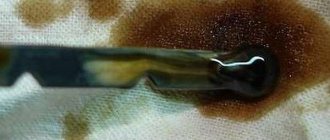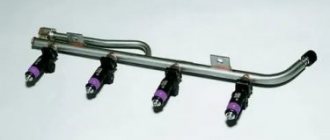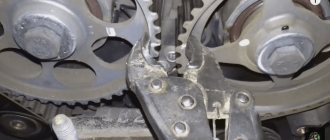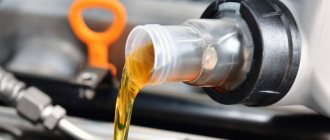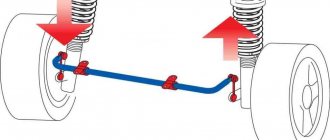What are hydraulic compensators?
To begin with, let’s take a closer look at the problems that hydraulic valve compensators help solve in modern engine building.
Let's turn to the domestic classics - VAZ cars. Experienced car owners probably remember how, after a certain mileage, old models of this brand began to work with the sound of a diesel engine, although they were never diesel.
This happened if they forgot to adjust the valves in time or adjusted them incorrectly, and it was necessary to perform this procedure.
The reason is heavy loads on the timing mechanisms, constant and sudden thermal expansions (thermal gaps). In a word, work in hellish conditions, which causes wear of parts, the adjustment accuracy of which should be fractions of degrees and millimeters.
The bubbling sound of the engine is just the tip of the iceberg of all problems.
Unadjusted gaps between the camshaft cams and pushers and, as a result, cylinder valves opening and closing at the wrong time, cause increased fuel consumption, reduced power of the power unit and other troubles.
Of course, the procedure for regularly adjusting the timing mechanism requires special skills and equipment, so engineers thought about how to automate this process. And they came up with it, creating hydraulic compensators.
Thanks to their clever design, they allow you to automatically maintain the same thermal gaps and compensate for the natural wear of metal parts.
Hydraulic compensators are installed between the valves and the camshaft, representing a kind of intermediate link. How do these mechanisms work?
Hydraulic compensators: what are they and why do they knock?
Modern cars are becoming more advanced and smart. This also applies to the gas distribution mechanism. It is very important that the valve always opens and closes at the right time, so that ideally there are no gaps between the camshaft and the valve itself. This offers many benefits, such as increased power and reduced fuel consumption.
Previously, valves were adjusted manually, then mechanical “wide” pushers appeared (which, by the way, are still used today on many cars), but the pinnacle of evolution was hydraulic compensators or simply “hydraulic compensators”. They have many positive aspects, but they also have a lot of negative ones, in particular they can knock.
Today I will try to talk about the device in a simple and understandable language, as well as some breakdowns, there will be a video version at the end...
First, the definition:
Hydraulic compensators are devices that use oil pressure to automatically adjust the clearances between valves and camshafts (or shaft). Thus, improving dynamic performance and reducing fuel consumption. It is worth noting that acoustic comfort also improves; the engine is simply quieter.
BUT before the advent of hydraulic compensators, mechanical valve adjusters were installed on cars...
A little history
Hydraulic compensators have replaced less efficient mechanical regulators of gas distribution mechanisms. As a rule, a regular engine valve, say on a classic VAZ 2105 - 2107 engine, does not have a hydraulic compensator, so it often had to be adjusted, on average after 10,000 kilometers. Valve adjustment on VAZ 2105 - 2107 was done manually, that is, you had to remove the valve cover and set the gaps using a special feeler gauge, which varied in thickness, which means you could choose it for your mileage.
If adjustments are not made, the car engine begins to make noise, dynamic characteristics decrease, and fuel consumption increases. I made a detailed video on why you need to adjust the valves, watch it useful.
After 40 - 50,000 kilometers, the valves generally should have been changed. That is, mechanical valve adjustment, to put it mildly, has outlived its usefulness, it was necessary to do something, to improve the design, so to speak.
So on front-wheel drive VAZ engines, they began to install mechanical pushers in front of the valve. To exaggerate, a large “cap” was simply put on top of the valve; it has a larger diameter (than the old design), and therefore wear was much reduced, because it is much more difficult to wear out a larger diameter than a small one. But adjustment still remains, of course not every 10,000 kilometers, much less often, but it is still recommended to do it. This usually happened by placing repair “washers” of increased height.
Mechanical adjustments are quite effective and are still used by some manufacturers; adjustment with washers is recommended no earlier than 40 - 50,000 kilometers (if we talk about our VAZs); on some foreign cars the pushers last even longer. The big advantages are the simplicity of the design, unpretentiousness (semi-synthetic oils can be poured), as well as the relative cheapness of the design. The disadvantages can be noted that when the “washers” on top were worn out, the engine began to work noisier, the dynamic characteristics dropped and the consumption increased.
Identifying faulty hydraulic compensators
In principle, it is not difficult to identify a knocking hydraulic compensator. It is enough to remove the valve cover from the car to gain partial access to them, which will be enough for checking.
To check the hydraulics, it is enough to use a thin wooden block.
The check is carried out by pressing on the bottom of the hydraulic valve. When force is created, it will begin to sink into its seat
When checking, it is important that the camshaft cam does not affect the bottom of the hydraulic valve.
A jammed hydraulic compensator will simply not be recessed into the seat by the created force; human impact will not be enough to overcome the forces of the valve spring.
If there is no oil in it for any of the listed reasons, the hydraulic valve will be recessed into the seat with significantly less force than when working normally.
POPULAR WITH READERS: Car repair tools
Using this method, you can calculate broken hydraulic compensators.
Verification methods
Now the motorist is faced with the task of finding out whether the expansion joints on his car are working or not. What is the best thing to do in such a situation?
There are two verification options.
- The first option involves removing the valve cover. The method is more visual and allows you to almost certainly guarantee the correct diagnosis. But implementation is more difficult due to dismantling work;
- The second option does not require the elements to be dismantled. But here you need good hearing. To improve it, it is better to use a phonendoscope. By listening to the operation of the main engine in different modes, you can find the source of the problems.
Which option should I choose? It's up to you to decide.
Both verification methods have their strengths and weaknesses. For a beginner in such matters, I would recommend starting by listening to the hydraulic compensators. If wiretapping does not yield anything, then open the valve cover and more clearly examine the condition of the elements.
Wiretap check
The preparation for the procedure is extremely simple. You need to place the car on a flat surface, open the hood, start the engine and listen.
Even perfect hearing does not always allow one to clearly recognize a non-working compensator. It is better to take an auxiliary medical instrument to help. It's not difficult to find.
And here we will consider several situations. Depending on the result of the check, we will draw appropriate conclusions.
- After starting the engine, the noise appeared at first, but disappeared after a few seconds. Everything is fine with compensators. Lubricant just temporarily leaked out of the cavities of the main body. The engine turned over and filled them;
- The speed is idle, and the noise from the compensators is intermittent. As soon as you raise the speed, the noise goes away. There is a problem. It lies in the bushing or blockages;
- The engine is warm, the speed is idling, the noise is continuous. By increasing the speed, the noise disappears. This means that the gap has increased;
- The symptoms are similar to the previous point, only at low speeds there is no noise, but at high speeds there is. Here you are faced with foaming of the oil;
- One or several knocking noises occur at once, regardless of engine speed. Any of the above malfunctions are possible here.
By applying the wiretapping tool one by one to the area where each of the compensators is located, you can understand where exactly the problem is.
If the noise of one HA differs from the others, you have found the source of trouble. All that remains is to figure out the reasons and eliminate the malfunctions.
Disassembly check
To check these elements for their functionality, you can remove the valve cover. Next, you will have to rely on your own feelings when checking elasticity.
You will have to turn the crankshaft using the center nut to do this. This will set the shaft in motion.
When the pusher cam is directed in the direction opposite to the main body, check the elements one by one for their elasticity, whether there is free play.
You can use your hands or available tools. When the compensator is loose and moves too softly, it is faulty. Needs renovation.
Types and design of hydraulic compensators
How the hydraulic compensator works: 1 – camshaft cam; 2 – recess in the body of the hydraulic compensator; 3 – plunger bushing; 4 – plunger; 5 – plunger valve spring; 6 – timing valve spring; 7 – gap between the camshaft cam and the working surface of the hydraulic compensator; 8 — ball (plunger valve); 9 – oil channel in the body of the hydraulic compensator; 10 – oil channel in the cylinder head; 11 – spring of the plunger pair; 12 – gas distribution valve.
These elements can be used in any type of timing belt that has rocker arms, rods or levers, both with an upper and lower camshaft.
However, depending on the type of gas distribution mechanism, one or another type of hydraulic compensators is selected:
- simple hydraulic supports;
- hydraulic supports for rocker arms or levers;
- simple hydraulic pushers;
- hydraulic pushers with a roller mechanism.
Modern engines mainly use hydraulic pushers. Their main elements are a plunger pair with a ball driven by a spring, a channel through which oil is supplied inside the mechanism, and a protective housing.
How do modern hydraulic compensators differ from mechanical pushers?
We owe much of the appearance of hydraulic valves to Japanese car designers, who were the first in the world to massively introduce this mechanism into the design of engine timing belts. It was they who began to pay a significant share of their attention not only to the main components and parts of the power unit itself, but also to its gas distribution mechanism. As for mechanical pushers, common at that time, their fall out of use in vehicle design was due to two main reasons.
Firstly, the operating principle of hydraulic compensators makes it possible to avoid frequent timing adjustments, which were typical for the previous version of control devices. Secondly, mechanical mechanisms produce much more noise compared to hydraulic ones. In addition, their utilitarianism, that is, practical benefit, lies in the fact that they cope with their function much better. Indeed, in modern engines, with rare exceptions, crankshafts usually operate at speeds up to 3,500 rpm and rarely exceed 5,000 rpm. In this mode, the design and operation of hydraulic compensators are completely justified - they do their job perfectly, do not require maintenance and are characterized by quiet operation. And everything would be fine if not for one annoying “but”: as soon as the engine crankshaft spins up to about 6,000 rpm, the hydraulic pushers simply cannot keep up with such “twisting”, they begin to knock and quickly fail.
How to check and find out which hydraulic compensator is knocking
Domestic cars tempt car owners with their ease of repair. Most service and repair work can be carried out independently, without contacting a service station and significantly saving the family budget. But before proceeding directly to the repair, you need to correctly diagnose the cause of the malfunction.
Using a Chevrolet Niva car as an example, we will tell you how to find out which hydraulic compensator is knocking on the engine timing belt.
Checking the knocking hydraulic compensator
You can first determine which hydraulic compensator you need to work closely on in a simple way. Those hydraulic compensators that are set at top dead center need to be lightly pressed down with a screwdriver, which is used as a lever.
If the hydraulic compensator “falls” under light pressure, it means that it is not adjusted and makes a knocking noise. You can even, for the “purity of the experiment,” quickly press the screwdriver lever and tap the hydraulic compensator.
This is where the marks are located on the motor.
After checking the hydraulic lifters alone, rotate the camshaft sprocket 180° so that the crankshaft rotates 360° accordingly. And proceed to check the next group. “Correct” hydraulic compensators “stand still” and do not respond to light pressure from a lever screwdriver.
After first identifying out-of-adjustment hydraulic lifters, make sure there is no error. This is easy to check; there is an old, “old-fashioned” method. After removing the camshaft box cover, press the “loose” hydraulic compensators with your finger. If there is no error, then they will press easily.
Adjusting hydraulic compensators does not always give the desired result. It happens that they turn out to be very worn out, and adjustment is simply not enough. The solution in this situation is to replace them with new ones.
After adjusting or replacing hydraulic compensators, check the operation of the motor. To do this, you need to start it. After starting the engine, a knocking noise is heard for some time. Don’t be alarmed right away; the hydraulic compensator must “bleed.” If everything went correctly, the knocking will soon stop.
To be on the safe side and finally make sure that everything was done correctly, turn off the engine. Wait a little and start it again, the knocking should not happen again. If we didn’t hear a knock, then the “bad” hydraulic compensators were identified correctly.
No matter how far the automotive industry has advanced, no matter how many electronic devices that detect car breakdowns have been invented, we often use old, proven, “old-fashioned” diagnostic methods for domestic cars. They are much more affordable, do not require expensive equipment and are not inferior in accuracy to innovative methods.
And when applied to domestic automotive equipment, which is often produced using outdated technologies, the “old-fashioned” methods of diagnosing cars are the most correct and accessible to ordinary car enthusiasts.
Hydraulic compensators
The engine heats up during operation, which leads to natural expansion of metal parts. Designers take this feature into account and therefore leave special thermal gaps. However, another feature of the engine is the gradual wear of parts; accordingly, the gaps widen and we observe such negative aspects as a decrease in power, a decrease in compression, increased oil and fuel consumption, and the gradual destruction of engine parts.
An important element of any gasoline internal combustion engine is the gas distribution mechanism.
Its main elements:
- camshaft with cams machined on it;
- intake and exhaust valves;
- valve tappets;
- camshaft pulley (drives the shaft to rotate thanks to the timing belt).
We have listed only the main elements, but in reality there are more. The very essence of the timing is to ensure that the camshaft rotates synchronously with the crankshaft, the cams alternately press on the pushers (or rocker arms), and they, in turn, set the valves in motion.
Over time, gaps form between the working surfaces of the camshaft and pushers (or rocker arms in V-shaped engines). To compensate for them, they used to use a simple adjustment mode using special marks and wrenches. The gaps had to be adjusted literally every 10-15 thousand km.
Today, this problem has practically disappeared thanks to the invention and widespread use of hydraulic compensators.
Design and principle of operation of the hydraulic compensator
Main elements of the hydraulic compensator:
- plunger pair (ball, spring, plunger bushing);
- a channel for oil to enter the compensator;
- frame.
The compensator is installed in the cylinder head in a specially designated place. It is also possible to install them on older types of engines in which their installation was not provided.
The operating principle is quite simple. The camshaft cam is irregularly shaped. When it does not press on the pusher, the gap between them increases. At this moment, the plunger spring presses on the plunger valve and oil from the lubrication system enters the compensator, the working part of the compensator rises slightly, moves the pusher and the gap between the cam and the pusher disappears.
When the camshaft makes a revolution and the cam begins to put a load on the pusher, the working part of the hydraulic compensator begins to lower until the oil supply channel is blocked. Accordingly, the pressure inside the compensator increases and is transmitted to the engine valve stem.
It was thanks to the introduction of hydraulic compensators that it was possible to achieve the following advantages of new engines over old ones:
- there is no need to constantly adjust valve clearances;
- engine operation has become softer and quieter;
- the amount of shock loads on the valves and camshaft has decreased.
The main problems of hydraulic compensators
It is worth noting that the plunger pair of the compensator is a very precise device. The gap between the sleeve and the plunger is several microns. In addition, the oil outlet channel is also of very small diameter. Therefore, these mechanisms are very sensitive to oil quality. They begin to knock and fail if low-quality oil is poured into the engine, or if there is a lot of slag, dirt, sand, and so on.
If there are deficiencies in the engine lubrication system, then the oil will not be able to flow into the compensators, and this will cause them to overheat and fail faster.
When installing or replacing expansion joints, make sure they are filled with oil. They are usually delivered already filled. If there is air inside, air jams may occur and the mechanism will not be able to perform its tasks.
If the car has been left idle for a long time, oil may leak from the expansion joints. In this case, you need to pump them: let the engine run at constant speeds, then at variable speeds, and then at idle - the oil will flow into the compensators.
In this video, a specialist will talk about the design and operating principles of hydraulic compensators.
//www.youtube.com/embed/xnpjMjTW1Z4
Why do you need to adjust valves?
If suddenly there is extraneous noise when the engine is running, then most likely you will have to check the engine or valves. Gazelle diagnostics:
- It is best to do the inspection using a stethoscope; the K-69M GARO model is suitable for this case.
- In this case, the gazelle engine must be warmed up, and it must be checked at different crankshaft speeds.
- You will have to listen carefully at the lowest speed, then at the middle one, starting with the distribution mechanism, and then checking the operation of the valves (750-1000 rpm).
Sounds from damaged valves are heard best in the place where the head is located, above their locations.
Disassembled engine 4216
And if a knock is heard on the side where the distribution mechanism is, in the place where the camshaft axis is located, then it is necessary to check the pusher and camshaft journals. But where the most vulnerable spot is located can be determined not only by problem areas, but also by sound level. There are sounds that are clear and loud, rattling and dull. If the valves, pistons and pushers on the Gazelle 4216 malfunction, when the engine has not been warmed up, knocking sounds will indicate that it is the engine that is damaged.
But if the sounds are too loud and they come from the valves or pushrods, or if the crankshaft speed increases and these sounds merge into a general hum, then the engine is fine.
It is necessary to adjust the Gazelle 4216 valves if they periodically knock, appearing and then disappearing if you sharply change the crankshaft speed.
Adjusting the valves of the Gazelle 4216
And if a specific clattering sound is heard in the engine compartment, it means that the required clearance has been violated, and the valves need to be adjusted or replaced. Having a business class Gazelle, you need to remember that every 1,500 km, preventing valve clearance and checking their condition is necessary.
Causes of hydraulic compensators knocking, how to determine what to do to avoid knocking
If an annoying and measured knock is constantly heard from under the hood while driving, the reason is most likely in the hydraulic compensators. This problem can appear on any machine, regardless of its manufacturer.
The knocking sound of hydraulic compensators can be heard both when cold and when hot, sometimes they appear after many years of use or shortly after purchasing a new car
To get rid of this problem, it is important to determine why the hydraulic compensators are knocking.
Causes
A hydraulic compensator is a special device that is used to adjust engine valve clearances. This is a small tube into which a plunger pair, a check valve and a spring are placed. With its help, valve adjustment does not need to be done manually. There may be several reasons:
- Wear of the plunger pair. Over time, the camshaft lobes form dents on this part;
- Defective components. Even the best factories owned by leading automakers sometimes make mistakes;
- Oil supply valve clogged. Contamination causes it to stick;
- Air bag. Sometimes air penetrates into the compensator, which may be a consequence of insufficient supply of lubricants;
- Component contamination. Dust or oil deposits may enter the system.
In some cases, there is air in the oil itself, or the cause of the breakdown is the failure of the oil supply channels
It is also important to select high-quality mixtures that are most suitable for your car.
Knocking on cold and hot - what is it?
These terms are often used by auto mechanics, and inexperienced drivers may not understand what is going on. A “hot” knock is heard when the engine heats up, most often the reason for this is the exhaustion of the service life of the filled oil. Replacing it or installing a new filter will help solve this problem. None of the above measures helped? This means that the cause should be sought in other engine components.
When hydraulic compensators knock when cold, the sound appears immediately after starting the engine. As a result of the problem, oil does not penetrate into the compensator, and drivers very often ignore the sound that occurs during startup, which can lead to serious problems in the future.
How to find out which hydraulic compensator is knocking?
An experienced specialist can easily identify a knocking hydraulic compensator by conducting acoustic diagnostics. After localizing the problem, the specialist washes the part, puts it back in place, and then restarts the engine. If the problem persists, then this part needs to be completely replaced.
In order to eliminate the knocking of hydraulic lifters by changing the oil, you need to choose the right lubricant; this approach is justified when the hydraulic lifters knock when hot. You can also try using a special anti-knock additive for hydraulic compensators, which will improve the properties of lubricants, making them more suitable for use with these components.
If the material was interesting or useful for you, publish it on your social network page:
Why are hydraulic compensators needed?
As the engine warms up to its operating temperature, parallel heating of other power unit devices occurs. The parts expand, causing the gaps between structural elements to decrease.
If we talk about the timing belt, the accuracy of the gaps is very important - the smooth operation of the internal combustion engine depends on it. Valve clearances can be adjusted either manually or using special devices. The valves are under constant thermal and shock loads. By the way, all timing parts heat up unevenly, and natural wear is the main “disease” of the valve mechanism.
The thermal gap ensures normal operation of the valve system. Due to contact with hot gases, the exhaust valves heat up much more than the intake valves, which is why the gaps here are larger. The adjusted clearances are constantly changing due to wear of the mechanism and for other reasons. Their changes lead to premature wear of the timing belt. The valves begin to knock, fuel is consumed rapidly, and engine power drops.
Exhaust valves suffer much more than intake valves. Hot gas passing through damaged seals can destroy the valve seat and valve plate. And the formation of a gap leads to an increase in shock loads and a loss of power by the power unit.
Adjusting the gaps can be done manually - but only with experience and appropriate skills. Adjustments should be carried out every 15,000 km. The procedure must be carried out taking into account temperature fluctuations - the average value is not taken into account here. With hydraulic compensators that automatically adjust the clearance, much fewer problems arise.
Advantages and disadvantages of the mechanism
The direct function of the hydraulic pusher is to adjust the gap between the crankshaft and the valve, since without it the engine is not capable of operating normally. The adjustment is carried out automatically by changing the engine oil pressure. This mechanism has a number of obvious advantages:
fuel consumption is more economical;
the service life and power of the power unit increases;
the dynamic performance of the car improves;
the service life of the gas distribution mechanism increases, fuel injection phases become more accurate;
The engine becomes almost silent and runs smoothly.
However, as with any scheme, it is not without its drawbacks. First of all, they are associated with frequent oil changes, which significantly hit the car owner’s pocket. After all, it is preferable to use synthetic lubricant, and it is often the most expensive.
Secondly, the noiselessness and efficiency of the timing depends on how the hydraulic valve compensator works. Unfortunately, over time, these engine components become clogged, which is why the gas distribution mechanism begins to make noise. In addition, it is quite difficult to repair such a structure on your own, and therefore you have to turn to auto mechanics. Accordingly, in order not to waste time and money, it is advisable for owners of passenger cars, regardless of their class, to constantly monitor the cleanliness of the engine. Moreover, the list of preventative maintenance is not so extensive - it is enough to change the oil on time and thoroughly rinse the power unit. And in general, it is advisable to eliminate any timing fault immediately after its occurrence.
Purpose and principle of operation of hydraulic compensators
Hydraulic compensators, or hydraulic compensators, are an integral part of the gas distribution mechanism (GRM) system in an internal combustion engine cylinder. When the engine warms up, timing parts heat up, which leads to an increase in their size. Therefore, thermal gaps are left between the timing parts - from 0.15 mm on the intake valves and up to 0.35 mm on the exhaust valves. One of the problems of the timing belt is mechanical wear and increase in valve clearances, as a result of which the valves do not open or close completely. The result of this is a decrease in vehicle power, difficulty starting the engine and increased exhaust toxicity. The reason for this is fuel combustion in the intake manifold or insufficient filling of the engine cylinders with the fuel mixture. Diesel cars, as a result of the incorrect size of thermal gaps, become completely inoperable.
To regulate valve clearance sizes, mechanical adjustment of levers and washers was previously used, then mechanical pushers appeared, and on modern cars they were replaced by hydraulic compensators. Hydraulic compensators automatically change their length to a size equal to the thermal gap in the timing belt.
In terms of its design, the hydraulic compensator is:
- a housing in the form of a cylindrical pusher or an integral part of the cylinder head;
- a plunger pair located in the body, consisting of a sleeve and a plunger (spring-loaded ball valve), the gap between the sleeve and the plunger is about 8 mm;
- plunger springs;
- check valve
The operation of the hydraulic compensator consists of several stages.
- At the first stage, the camshaft cam is located on the opposite side of the hydraulic compensator. The plunger spring pushes the plunger out, resulting in increased clearance. Oil enters the cavity under the plunger through the oil channel, after which the valve closes under the influence of the plunger spring. At this stage, the plunger rises and compensates for the gap.
- Under the influence of the camshaft, the cam begins to press on the pusher and moves it to the lower position. The ball valve closes, and the plunger pair begins to work as a rigid element due to the fact that the oil is not compressed.
- When the plunger pair moves down, some of the oil flows out of the cavity, which is compensated by additional portions of oil from the car system. The length of the hydraulic compensator increases slightly, creating a gap. Its size is equalized by portions of oil supplied from the vehicle’s lubrication system.
The main advantage of hydraulic compensators is a completely automatic operating mode that does not require adjustment, since the hydraulic compensator always selects the required gap.
Operating principle of hydraulic valve compensators
For engine operation, one of the most important characteristics is the clarity and timeliness of each action of each component of the overall system. This is especially true for the gas distribution mechanism - not only the efficiency of the engine, but also its durability depends on how well its components work. The valve must always open at the right time and close before the piston rises. And the gaps between the elements should be minimal. Hydraulic compensators make it possible to reduce such gaps, which inevitably exist in the design of any engine. This is perhaps one of the most important elements of the timing belt, saving the car owner from many problems.
Common hydraulic compensator faults
The most common malfunctions can be divided into several categories:
- clogging with oil decomposition products or other foreign bodies. Here the main reason is the use of low-quality lubricant, which can degrade and separate, or the ingress of foreign contaminants. Clots with high viscosity, and sometimes even hardened particles, can clog the system both at the supply level and inside the hydraulic compensator. This either completely paralyzes the work or makes it difficult;
- insufficient filling. It can either be a consequence of contamination or indicate low pressure generated by the pump. In the case of a pump, the problem needs to be resolved immediately, since not only the compensators suffer, but also all the rubbing elements;
- production in a plunger pair. This does not ensure complete locking of the lubricant inside the bushing or, in advanced cases, its jamming;
- dysfunction of the ball locking device. The most common cause is clogging. The plunger pair ceases to perform its functions. Shock loads appear;
- the appearance of scoring and roughness on the walls of the compensator and in the cylinder head recess. This makes reciprocating movement difficult. This, in particularly advanced cases, can lead to incomplete closure of the inlet or outlet channel and even jamming.
Correcting the situation
It becomes very simple to finish what you started after identifying all possible causes:
- If the reason why the hydraulic compensators are knocking when cold is the products themselves, then they will have to be replaced simply.
- If there is an incorrect amount of oil, add it or, conversely, drain the excess.
- When clogged, the filter element is replaced.
- The same should be done if damage to the pumping equipment is detected.
If the car owner was unable to identify any obvious signs of such noise occurring when operating his car, then it is recommended to purchase and use higher quality oil. If this does not bring results, then there is only one way out - sending the vehicle to a good service station, where more experienced specialists will be able to select the “optimal treatment”.
For long-term operation of the car, it is important not only to visually inspect the mechanisms, but also to listen to the sounds that it makes. For example, by ear you can diagnose the case when hydraulic compensators are knocking
To facilitate the operation of the car and eliminate the need to regularly adjust the valve clearance, manufacturers have developed and began to commercially use hydraulic compensators. However, their use not only makes life easier for the car owner, but can also cause concern about what to do if there are extraneous sounds from the engine compartment.
The most common reason why hydraulic compensators knock is oil.
The car owner needs to pay attention to the following factors that can cause knocking of hydraulic compensators:
- the oil must comply with the manufacturer's recommendations
- Oil changes must be done on time
- The oil filter is replaced at the same time as the oil change.
- the oil must match the climatic conditions
The most important thing when choosing an oil is that its viscosity matches the manufacturer's recommendations. Hydraulic compensators will knock if:
- oil is too viscous
- oil is too thin
If the oil is too viscous, the hydraulic compensators usually knock when cold, since insufficient oil is supplied through the channels. As the oil heats up, it becomes more liquid and can easily fill the entire system. Therefore, the knocking when hot usually goes away.
If the oil is too thin, then on some cars a situation arises that the oil pump is not able to create optimal pressure in the system. As a result, oil starvation occurs and the knocking of hydraulic compensators, which is more clearly audible on a warm engine, occurs. If the oil pump breaks down, a similar situation arises.
The same situation can arise if the oil does not match the climatic conditions.
To eliminate the knocking of hydraulic compensators in this case, it is necessary to change the oil. If the oil change is carried out in a garage, then it is necessary to ensure that the oil fully complies with the requirements of the car manufacturer.
How to replace the hydraulic compensator yourself?
Replacing hydraulic pushers with new ones is considered a logical solution only when washing them does not produce any results. This means that these parts have simply worn out and are no longer able to perform their function. However, installing functional compensators is sometimes fraught with difficulties and financial costs, since it is not only the “regulators” that will have to be changed.
First you need to remove the faulty mechanism. A magnet is usually used for this, since this part is already capable of moving freely. It’s another matter when it “sticks” to the surface - then a special puller is required. The second stage consists of flushing the lubricating fluid supply system, replacing the oil filter and filling in new oil. In addition, you will have to first check whether oil is supplied to the seat for the hydraulic compensators - you will only need to rotate the crankshaft a few times. This stage is very important, since the installation of parts to which insufficient oil is supplied causes critical shock loads.
Based on the principle of operation of hydraulic compensators, after replacing them, it is not recommended to immediately start the engine and return it to normal mode. Using the ignition key, you just need to turn the crankshaft a few times and wait half an hour, or better yet, an hour. Over a given period of time, the oil pressure in the system is normalized, and the hydraulic pushers themselves will “find” their places.
However, the question arises: how many valve compensators need to be replaced? The answer to this is found directly by the car owner. For example, 1 or 2 mechanisms have failed. In this case, in the absence of “free” money, only they are changed, and the rest are subject to repair or maintenance. However, the optimal solution is a comprehensive replacement, which guarantees the absence of problems in this part of the timing belt for a fairly long period. In addition, it is recommended to use only high-quality oil - it can extend the “life” of not only hydraulic compensators, but also other engine components under load.
Hydraulic compensator device
A hydraulic compensator is a device that regulates engine valve clearances. The engine can heat up during operation, which leads to natural expansion of the metal elements. Designers take such features into account and therefore create special thermal gaps. However, another feature of the engine is the gradual wear of the elements, which accordingly widens the gaps and we see such negative aspects as decreased compression, gradual destruction of engine elements, decreased power and increased fuel and oil consumption.
An important part of any gasoline internal combustion engine is the gas distribution system. Its main details:. 1. The camshaft pulley, which begins to rotate with the help of the timing belt (gas distribution mechanism)
1. The camshaft pulley, which begins to rotate with the help of the timing belt (gas distribution mechanism).
2. Valve pushers.
3. Exhaust and intake valves.
4. Camshaft with cams machined on it.
Only the main details are listed here, but in reality there are more. The essence of the timing is the synchronous rotation of the camshaft with the crankshaft, alternating pressure of the cams on the pushers, which sets the valves in motion.
There are several types of hydraulic compensators:
1.Hydraulic pusher.
2. Roller hydraulic pusher.
3. Hydro support.
4. Hydraulic support for installation in rocker arms or levers.
Under the influence of time, gaps form between the pushers (rocker arms) and the working surfaces of the camshaft. Once upon a time, to compensate for them, a simple adjustment mode was used using wrenches and special marks. It was necessary to adjust the gaps almost every ten or fifteen thousand kilometers. Today, such a problem practically does not exist thanks to the creation and active use of hydraulic compensators.
Although hydraulic compensators come in different types, basically the principle of their operation and design are no different. Main parts of the hydraulic compensator:
1.Body.
2. Channel for entering oil into the compensator.
3. Plunger pair - plunger bushing, spring, ball.
The hydraulic compensator is mounted in a specially designated place in the head of the cylindrical block. In addition, they can be installed on older types of motors in which their installation was not provided.
The operating principle of the hydraulic compensator is quite simple. The camshaft cam has irregular shapes. When it does not press on the pusher, the gap between them increases. At the same moment, the plunger spring presses on the plunger valve and oil flows from the lubrication system into the compensator, which slightly raises the working part of the hydraulic compensator, sets the pusher in motion and the gap between the pusher and the cam disappears.
When the camshaft rotates and the cam begins to put a load on the pusher, the working part of the hydraulic compensator lowers until the oil supply channel is blocked. Thus, the pressure inside the compensator increases and is transmitted to the motor valve stem.
Thanks to the use of hydraulic compensators, it was possible to achieve several advantages of new engines over old ones:
1.The number of shock loads on the camshaft and valves has decreased.
2. The operation of the motor has become quieter and softer.
3. There is no longer a need to periodically adjust valve clearances.
Design and principle of operation of hydraulic compensators
| The dimensions of the parts of a running internal combustion engine increase due to heating. To prevent this from leading to breakdowns, accelerated wear, and deterioration in the performance of power units, thermal gaps are created between some parts at the design stage. When the engine warms up, due to the expansion of the parts, they are “selected” (absorbed). However, as parts wear out, their heating is not enough to absorb the gaps, which negatively affects engine performance. The thermal gap in the valve drive mechanism directly affects the performance of the power unit. Since valve clearances are constantly changing due to wear of parts, at the beginning of the last century a mechanism for adjusting them was introduced into the engine using ordinary wrenches. This had to be done regularly, which means that the labor intensity of maintenance increased and its cost increased. Hydraulic compensators (HC) allow you to avoid these problems. They must completely absorb the gaps between the working surfaces of the camshaft and the rockers, rocker arms, valves, rods - regardless of the temperature conditions and the degree of wear of the parts. |
Hydraulic compensators can be installed on all types of gas distribution mechanisms (GRM) - with rocker arms, levers, rods - and with any camshaft location (upper or lower, Fig. 1).
Depending on the design of the timing belt, there are four basic types of hydraulic compensators (see photo below): hydraulic pushers; hydraulic supports; hydraulic supports designed for installation in levers or rocker arms; roller hydraulic pushers.
The troubles and victories of hydraulic compensation. Why are hydraulic pushers needed, what are their resources, what destroys them
Thermal expansion due to heating is a tricky thing. For example, if the valve of the gas distribution mechanism, due to thermal expansion of the metal, elongates so much that the end of its rod rests against an adjacent part in the kinematic timing diagram, the valve plate will not be able to fit tightly into the seat and ensure the tightness of the combustion chamber.
As a result, compression is lost, the engine does not develop power, and the valve disc, having lost the ability to transfer heat to the cylinder head and cool while seated in the seat, overheats and may burn out, which will require expensive repairs of the power unit to eliminate the malfunction.
To avoid the negative effects of thermal expansion of valves, clearances must be provided between the valves and their tappets. They are called thermal, which clearly indicates the purpose of the gaps - to protect the motor from problems associated with changes in size due to different expansion of differently heated parts.
However, wear, which during operation, in addition to the valve seats in the cylinder head, sealing chamfers on the plates and the thrust ends of the valve stems, also affects other rubbing parts of the drive, is no less insidious than thermal expansion.
As wear occurs, the gap established during assembly line assembly of the engine in case of thermal expansion increases. This leads, firstly, to a reduction in the period when the valve is open. The valve opens later and closes earlier, which, depending on whether this happens with the intake or exhaust valve, has a negative effect on filling the cylinders with fresh charge and cleaning them from exhaust gases. This distortion of valve timing causes a decrease in engine power and an increase in fuel consumption.
Secondly, due to the fact that as the clearance increases, the camshaft cam prematurely breaks away from the pusher, the valve plate begins to return to the seat not smoothly, as it should, but with a blow. And the camshaft cam, instead of smoothly pressing the pusher, also begins to hit it. Impact work accelerates wear and can contribute to the appearance of microcracks on the contact surfaces, the further development of which, apparently, explains many of the known cases of valve seats falling out of the cylinder head. Indicates that timing parts are experiencing shock loads and noise.
This means that the mere presence of a thermal gap is not enough. It is also necessary to provide for the possibility of adjusting it during engine operation and prescribe this procedure as mandatory during maintenance.
But there is another way out. To get rid of the troubles associated with thermal expansion and wear, a special device was developed that automatically selects the thermal clearance in the valves and compensates for the effects of mechanical wear.
For users, the most obvious advantage of using hydraulic compensators in the gas distribution mechanism is the absence of the need to periodically check and adjust valve clearances.
However, the above illustrates that what is much more important is that, thanks to the operation of hydraulic compensators, the optimal valve timing remains practically unchanged and with them the dynamic and economic characteristics of the engine, as well as the component composition of the exhaust gases. In addition, the use of hydraulic compensators reduces the noise level from the engine, and since this indicates a decrease in dynamic loads, we can talk about increasing the durability of timing parts.
Another name for hydraulic thermal gap compensators is hydraulic pushers, but it is truly valid only for units located directly in front of the valves. However, depending on the kinematic diagram of the valve drive and design considerations, hydraulic compensators can be located at other drive points.
In particular, if there are rocker arms in the valve drive, which are a double-arm lever, the hydraulic compensator is often made in the form of a support for the arm opposite to the arm that acts on the valve.
Such nuances make hydraulic compensators visually different from each other, but this does not change their structural essence.
The hydraulic compensator consists of a housing, a piston, a spring placed between them and a shut-off valve. The spring expands the body and piston in different directions, resulting in the valve clearance being selected. Oil enters the cavity formed in the internal volume above the piston from the engine lubrication system under pressure and creates a backstop that ensures a backlash-free kinematic connection between the valve and its drive parts during engine operation.
When the hydraulic compensator is pressed with a cam or rocker arm, the valve locks the oil cavity above the piston from the inside. This prevents oil from flowing back out of the cavity through the inlet. Oil losses through the gap between the housing and the piston are replenished during the “rest” period, when the cam or rocker arm stops putting pressure on the hydraulic compensator.
Everything has a service life, and the hydraulic compensator has one too. The hydraulic compensator works normally as long as the oil leaks from the cavity above the piston are compensated for during the “rest” period. But when the balance is upset in the direction of leaks, the drive begins to operate with shocks that will make themselves known with characteristic knocks.
Oil can be squeezed out of the hydraulic compensator too quickly for two reasons. Firstly, the gap between the piston and the inner surface of the housing has increased excessively due to natural wear that accompanies the movement of any parts rubbing against each other.
The second reason is a malfunction of the valve that locks the internal cavity of the hydraulic compensator. For the valve, not only wear is critical, but also deposits of oil aging products.
In addition to problems associated with oil leakage, there is another problem that can occur with a hydraulic compensator - jamming of the piston in the housing. As manufacturers indicate, this is the main reason for returning hydraulic compensators during the warranty period. However, even after it has expired, foreign particles that have entered the hydraulic compensator along with the oil and penetrated into the gap between the plunger and the sleeve can also cause jamming.
In any case, the quality of the lubricant determines the service life of hydraulic compensators. Hence the demands on the characteristics of the engine oil and strict adherence to the frequency of oil and oil filter changes.
But what is the service life of hydraulic compensators? If you study the information from the manufacturers of these devices, it turns out that you can count on trouble-free operation only up to a mileage of 120 thousand km. Next - how the cards will fall.
Undoubtedly, the announced figure will add fuel to the fire of debate about what is better - hydraulic compensators or their absence and manual adjustment of thermal clearances, because, as practice shows, it may also be needed only for the specified mileage. Or it may not be necessary - operating practice also knows this. If we take into account all the advantages and disadvantages of using hydraulic compensators, the truth, apparently, as usual, is somewhere in the middle.
Sergey BOYARSKIKH Photos by the author and from open sources ABW.BY
